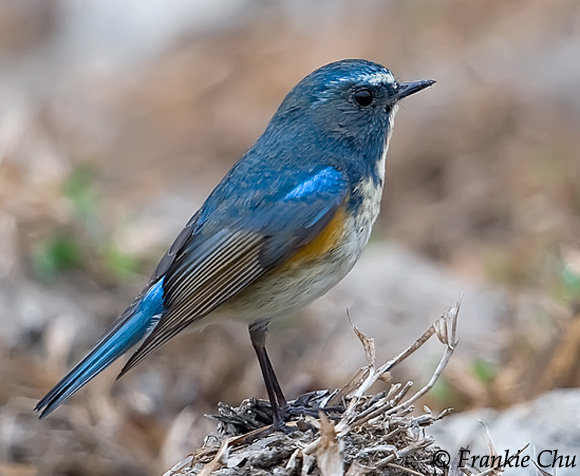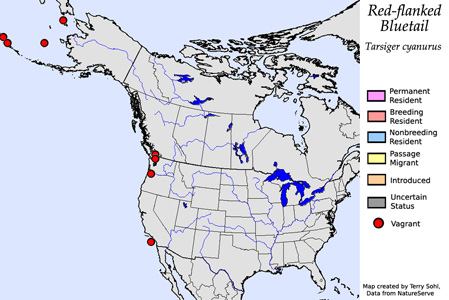| Length: 5.5 inches | Wingspan: 8.5 inches | Seasonality: Non-resident in South Dakota |
| ID Keys: Orange flank, blue tail, pale throat and belly for both males and females. Males brilliant blue upperparts, females grayish-brown upperparts. | ||
 The
Red-blanked Bluetail (also known as the Orange-flanked Bush-robin) is a
songbird found in Eurasia. During the summer they breed from
Scandanavia, eastward through Russia, Korea, northern China, and Japan.
In Europe, they have been expanding their range westward in recent decades,
being found more frequently as a breeder in Scandanavia, and also being
found further east in migration. In North America, they are primarily
known from several records in the Aleutian Islands or other Alaskan islands
in the Bering Seas. However, there are also a pair of records on the
islands off the coast of California, and a handful of records in the
northwestern U.S. and southwestern Canada.
The
Red-blanked Bluetail (also known as the Orange-flanked Bush-robin) is a
songbird found in Eurasia. During the summer they breed from
Scandanavia, eastward through Russia, Korea, northern China, and Japan.
In Europe, they have been expanding their range westward in recent decades,
being found more frequently as a breeder in Scandanavia, and also being
found further east in migration. In North America, they are primarily
known from several records in the Aleutian Islands or other Alaskan islands
in the Bering Seas. However, there are also a pair of records on the
islands off the coast of California, and a handful of records in the
northwestern U.S. and southwestern Canada.
Habitat: Found in mixed conifer or conifer forest during the summer breeding season, with a preference for forest lands with a dense shrubby undergrowth. Often found in areas of old-growth spruce forest.
Diet: Feeds heavily on insects, spiders, and other small invertebrates, particularly during the summer breeding season. They will also feed on berries and seeds, especially outside of the breeding season.
Behavior: Feeds by actively by hopping along the ground or clambering through low vegetation. They will also sometimes make short flights to capture insects in flight. They will often flick their tail as they move about.
Nesting: The nest is a cup built in a depression or cavity on the ground, typically placed next to a stump or other protected aera. The depression is lined with grasses, moss, and other material. The female lays 4 to 7 eggs, and she alone incubates them. The eggs hatch after about 2 weeks, and both parents help to raise the young. The young fledge about 2 weeks after hatching.
Song: The song is a short cheerful warble of about 2 or 3 seconds. They also have a harsh kek-kek call.
Migration: Strongly migratory, found in northern parts of eastern Europe and much of Asia in the summer, and wintering in southeastern Asia.
Interactive eBird map: Click here to access an interactive eBird map of Red-flanked Bluetail sightings
Similar Species: Distinctive if seen well, particularly the brightly colored males.
Conservation Status: Red-flanked Bluetail are found across a broad geographic area, are common in parts of their range, and overall populations are considered stable. The IUCN lists the Red-flanked Bluetail as a species of "Least Concern".
Further Information: 1) BirdLife International - Red-flanked Bluetail
2) WhatBird - Red-flanked Bluetail
3) BirdFellow - Red-flanked Bluetail
Photo Information: Photo by Frankie Chu - Licensed under Creative Commons Attribution NoDerivs 2.0 Generic License
| Click below for a higher-resolution map |
 |
| South Dakota Status: Non-resident in South Dakota |
Additional Red-flanked Bluetail Photos (coming soon!!)
